Items filtered by date: May 2023
Ways to Avoid Toenail Fungus Infections
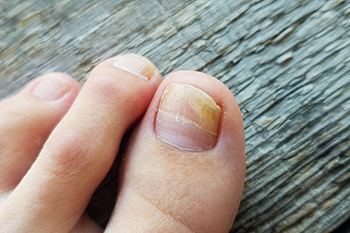
The toenails are easily ignored when thinking about basic healthcare, but there are many simple ways to keep them pain and problem free. Probably the two most common ailments are ingrown toenails and toenail fungus. An ingrown toenail is usually the result of the nail being cut incorrectly. It is suggested that cutting toenails straight across and not too short can prevent the nail from growing into the nail bed rather than over it. Fungal infections of the toenails can easily be spread in warm and moist areas, such as gym locker rooms and indoor swimming pools. Wearing protective foot coverings is a good way to prevent this annoying infection. Fungal toenail infections are extremely contagious, so it’s wise to keep from touching the infected area. If you have toenail fungal infections that recur, even after applying commercial anti-fungal remedies, it is a good idea to make an appointment with a podiatrist who can prescribe more powerful medication. In addition, trying to fix an ingrown toenail can lead to a bacterial infection. It is suggested that you make an appointment with a podiatrist who can safely deal with the problem.
For more information about treatment, contact Lance Greiff, DPM of Great Neck Podiatry. Our doctor can provide the care you need to keep you pain-free and on your feet.
Toenail Fungus Treatment
Toenail fungus is a condition that affects many people and can be especially hard to get rid of. Fortunately, there are several methods to go about treating and avoiding it.
Antifungals & Deterrence
Oral antifungal medicine has been shown to be effective in many cases. It is important to consult with a podiatrist to determine the proper regiment for you, or potentially explore other options.
Applying foot powder on the feet and shoes helps keep the feet free of moisture and sweat.
Sandals or open toed shoes – Wearing these will allow air movement and help keep feet dry. They also expose your feet to light, which fungus cannot tolerate. Socks with moisture wicking material also help as well.
If you have any questions please feel free to contact our offices located in Great Neck Bronx, NY . We offer the newest diagnostic tools and technology to treat your foot and ankle needs.
How to Take Care of Your Feet
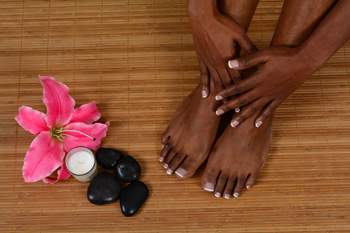
We underestimate how much time we spend on our feet and how much wear and tear they go through. When we stop and think about just how much our feet do for us, we can more fully appreciate the need to spend some time and energy taking care of them. A foot care routine can easily be implemented, and the payoffs are substantial. A proper foot care routine starts with looking at the feet more frequently to assess whether there are cuts, cracked heels, corns, or blisters that need to be tended to. Those with diabetes need to use particular care in examining their feet for developments that can turn into infections. Good regular foot care includes washing, drying, and moisturizing the feet each day, wearing shoes that are comfortable and the right size, and keeping the toenails trimmed by cutting them straight across and rounding the edges with a nail file. A pampering foot massage and a pedicure are icing on the cake in foot care. If you want to know more about how you can take care of your feet, it is suggested that you talk to a podiatrist about what other things you can do to maintain their health and functioning.
Everyday foot care is very important to prevent infection and other foot ailments. If you need your feet checked, contact Lance Greiff, DPM from Great Neck Podiatry. Our doctor can provide the care you need to keep you pain-free and on your feet.
Everyday Foot Care
Often, people take care of their bodies, face and hair more so than they do for their feet. But the feet are a very important aspect of our bodies, and one that we should pay more attention to. Without our feet, we would not be able to perform most daily tasks.
It is best to check your feet regularly to make sure there are no new bruises or cuts that you may not have noticed before. For dry feet, moisturizer can easily be a remedy and can be applied as often as necessary to the affected areas. Wearing shoes that fit well can also help you maintain good foot health, as well as making it easier to walk and do daily activities without the stress or pain of ill-fitting shoes, high heels, or even flip flops. Wearing clean socks with closed shoes is important to ensure that sweat and bacteria do not accumulate within the shoe. Clean socks help to prevent Athlete’s foot, fungi problems, bad odors, and can absorb sweat.
If you have any questions please feel free to contact our offices located in Great Neck Bronx, NY . We offer the newest diagnostic and treatment technologies for all your foot and ankle needs.
What Is Twisting the Ankle?
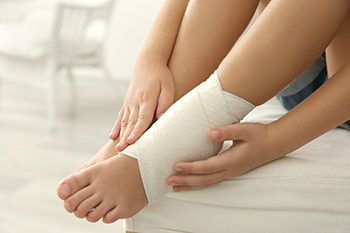
Even novices to the field of podiatry might be familiar with what some people call a twisted ankle. But what exactly does it mean to twist one’s ankle? The answer is that twisting the ankle is another way to say that the foot is inverted or moved outwards in an awkward position. As a result of this, an individual might suffer an ankle sprain. The patient’s outer, or lateral, ligaments might be stretched past their natural point, contributing to the sprain. There are many common symptoms associated with a sprained ankle. For example, a person might experience pain, swelling, or bruising. Importantly, a sprained ankle is distinct from a broken ankle, which occurs when the ankle bone becomes fractured. If you are someone that is currently living with a twisted or sprained ankle, it is suggested that you contact a podiatrist to schedule an appointment today.
Ankle sprains are common but need immediate attention. If you need your feet checked, contact Lance Greiff, DPM from Great Neck Podiatry. Our doctor can provide the care you need to keep you pain-free and on your feet.
How Does an Ankle Sprain Occur?
Ankle sprains take place when the ligaments in your ankle are torn or stretched beyond their limits. There are multiple ways that the ankle can become injured, including twisting or rolling over onto your ankle, putting undue stress on it, or causing trauma to the ankle itself.
What Are the Symptoms?
- Mild to moderate bruising
- Limited mobility
- Swelling
- Discoloration of the skin (depending on severity)
Preventing a Sprain
- Wearing appropriate shoes for the occasion
- Stretching before exercises and sports
- Knowing your limits
Treatment of a Sprain
Treatment of a sprain depends on the severity. Many times, people are told to rest and remain off their feet completely, while others are given an air cast. If the sprain is very severe, surgery may be required.
If you have suffered an ankle sprain previously, you may want to consider additional support such as a brace and regular exercises to strengthen the ankle.
If you have any questions please feel free to contact our offices located in Great Neck Bronx, NY . We offer the newest diagnostic tools and technology to treat your foot and ankle needs.
Drinking Water and Foot Health During Pregnancy
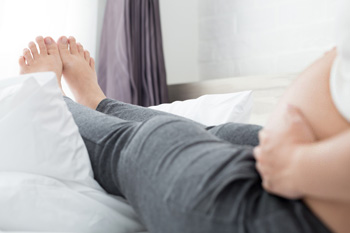
An individual requires a significant amount of water every day. Many people drink far less water than is recommended on a daily basis. This might become problematic during a pregnancy. Pregnant women can reap many health benefits by drinking water daily and staying hydrated. Some of these benefits are linked to foot health. For example, when pregnant women drink a lot of water during pregnancy, this can reduce the amount of salt in the body, which leads to a reduction in puffiness or swelling. Drinking coffee can complicate matters by exacerbating dehydration. If you are pregnant or planning to be, it is suggested that you schedule an appointment with a podiatrist so that you can plan to best protect the health of your feet.
Pregnant women with swollen feet can be treated with a variety of different methods that are readily available. For more information about other cures for swollen feet during pregnancy, consult with Lance Greiff, DPM from Great Neck Podiatry. Our doctor will attend to all of your foot and ankle needs.
What Foot Problems Can Arise During Pregnancy?
One problem that can occur is overpronation, which occurs when the arch of the foot flattens and tends to roll inward. This can cause pain and discomfort in your heels while you’re walking or even just standing up, trying to support your baby.
Another problem is edema, or swelling in the extremities. This often affects the feet during pregnancy but tends to occur in the later stages.
How Can I Keep My Feet Healthy During Pregnancy?
- Wearing orthotics can provide extra support for the feet and help distribute weight evenly
- Minimize the amount of time spent walking barefoot
- Wear shoes with good arch support
- Wear shoes that allow for good circulation to the feet
- Elevate feet if you experience swelling
- Massage your feet
- Get regular, light exercise, such as walking, to promote blood circulation to the feet
If you have any questions please feel free to contact our offices located in Great Neck Bronx, NY . We offer the newest diagnostic and treatment technologies for all your foot and ankle needs.
Are You Suffering From Nerve Damage?
Why Do Blisters Develop?
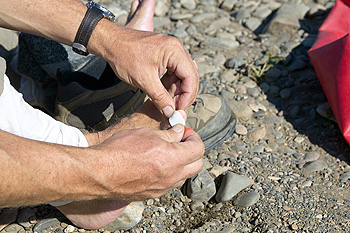
Many people enjoy walking and may be concerned about blisters developing on their feet. Blisters produce pain and discomfort and may also cause the gait, or walking style, to change. Blisters are often caused by excess friction due to the shoes and socks that are worn. A common place they develop is on the back of the heel as the foot rubs against the shoe. With enough friction, a bubble forms that is filled with a protective liquid to protect the damaged skin. The bubble will gradually drain as new skin forms under it, and a bandage may be worn to help prevent it from popping prematurely. There may be existing medical conditions, like psoriasis and eczema, that can cause a blister to form. Frostbite, extreme sunburn, or an allergic reaction to an insect bite may also result in a blister. If you would like to learn about effective blister prevention methods, it is suggested that you confer with a podiatrist who can provide you with the information you are seeking.
Blisters are prone to making everyday activities extremely uncomfortable. If your feet are hurting, contact Lance Greiff, DPM of Great Neck Podiatry. Our doctor can provide the care you need to keep you pain-free and on your feet.
Foot Blisters
Foot blisters develop as a result of constantly wearing tight or ill-fitting footwear. This happens due to the constant rubbing from the shoe, which can often lead to pain.
What Are Foot Blisters?
A foot blister is a small fluid-filled pocket that forms on the upper-most layer of the skin. Blisters are filled with clear fluid and can lead to blood drainage or pus if the area becomes infected.
How Do Blisters Form?
Blisters on the feet are often the result of constant friction of skin and material, usually by shoe rubbing. Walking in sandals, boots, or shoes that don’t fit properly for long periods of time can result in a blister. Having consistent foot moisture and humidity can easily lead to blister formation.
Prevention & Treatment
It is important to properly care for the affected area in order to prevent infection and ease the pain. Do not lance the blister and use a Band-Aid to provide pain relief. Also, be sure to keep your feet dry and wear proper fitting shoes. If you see blood or pus in a blister, seek assistance from a podiatrist.
If you have any questions, please feel free to contact our offices located in Great Neck Bronx, NY . We offer the newest diagnostic and treatment technologies for all your foot care needs.


